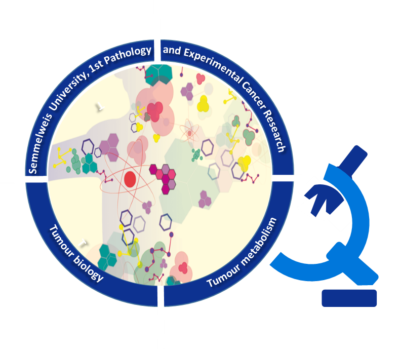Tumour biology – Tumour metabolism research group
 Failures in signalling pathways could contribute to the alterations occurring in cellular metabolism of tumour cells. As a key element of signalling network, mTOR (mammalian target of rapamycin) regulates several cellular functions depending on the available nutrients, energy and other factors/the oscillating energy status, nutrient and other factor availability. Appropriate regulation of mTOR can influence cellular metabolic activity including glucose and glutamine uptake, glutaminolysis, lipid metabolism or oxidative phosphorylation. Deregulated mTOR signalling are well-known in changes leading to carcinogenesis. Our results also highlight that there is a significant correlation among high mTOR activity – especially in case it is mTORC2 complex related –, worse prognosis and therapy resistance. We study the role and importance of mTORC1 and C2 complexes in relation of therapy resistance, metabolic adaptation and metabolic plasticity of tumours. In parallel, we investigate the tissue and metabolic heterogeneity, immune-microenvironment and additionally its potential diagnostic and therapeutic impact in a wide-range of tumours. Beside the characterisation of human tumour tissues, we involve in vitro and in vivo model systems in our experimental designs. We established the 3D bioprinting technique in tumour modelling, 3D bioprinted tissue-like structures. In relation to these, our aims are both optimising and characterising the experimental approach of metabolic adaptation and developing the pre-selection method of a better anti-tumoural agent. As a matter of course, molecular biology and analytical chemistry methods and even metabolic profiling (both metabolite and protein studies) gain important roles in these studies.
Failures in signalling pathways could contribute to the alterations occurring in cellular metabolism of tumour cells. As a key element of signalling network, mTOR (mammalian target of rapamycin) regulates several cellular functions depending on the available nutrients, energy and other factors/the oscillating energy status, nutrient and other factor availability. Appropriate regulation of mTOR can influence cellular metabolic activity including glucose and glutamine uptake, glutaminolysis, lipid metabolism or oxidative phosphorylation. Deregulated mTOR signalling are well-known in changes leading to carcinogenesis. Our results also highlight that there is a significant correlation among high mTOR activity – especially in case it is mTORC2 complex related –, worse prognosis and therapy resistance. We study the role and importance of mTORC1 and C2 complexes in relation of therapy resistance, metabolic adaptation and metabolic plasticity of tumours. In parallel, we investigate the tissue and metabolic heterogeneity, immune-microenvironment and additionally its potential diagnostic and therapeutic impact in a wide-range of tumours. Beside the characterisation of human tumour tissues, we involve in vitro and in vivo model systems in our experimental designs. We established the 3D bioprinting technique in tumour modelling, 3D bioprinted tissue-like structures. In relation to these, our aims are both optimising and characterising the experimental approach of metabolic adaptation and developing the pre-selection method of a better anti-tumoural agent. As a matter of course, molecular biology and analytical chemistry methods and even metabolic profiling (both metabolite and protein studies) gain important roles in these studies.
Related own publications
- Petővári G, Moldvai D, Raffay R, Dankó T, Sztankovics D, reszegi A, Miyaura R, Gelencsér R, Rókusz A, Tolnai-Kriston Cs, Vilimi Zs, Kállai-Szabó N, Visnovitz T,Sebestyén A: Mimicking breast cancer tissue—3D bioprinted models inaccurate drug sensitivity tests. VIEW. 2025;6:20250092. https://doi.org/10.1002/VIW.20250092
- Moldvai D, Sztankovics D, Dankó T, Vetlényi E, Petővári G, Márk Á, Patonai A, Végső G, Piros L, Hosszú Á, Pápay J, Krencz I, Sebestyén A. Tumorigenic role of tacrolimus through mTORC1/C2 activation in post-transplant renal cell carcinomas. Br J Cancer. 2024 Apr;130(7):1119-1130. doi: 10.1038/s41416-024-02597-8.
- Sztankovics D, Szalai F, Moldvai D, Dankó T, Scheich B, Pápay J, Sebestyén A, Krencz I. Comparison of molecular subtype composition between independent sets of primary and brain metastatic small cell lung carcinoma and matched samples. Lung Cancer. 2025 Jan;199:108071. doi: 10.1016/j.lungcan.2024.108071.
- Sztankovics D, Szalai F, Moldvai D, Dankó T, Nagy N, Pápay J, Khoór A, Krencz I, Sebestyén A. Increased mTOR activity and RICTOR copy number in small cell lung carcinoma progression. Eur J Cell Biol. 2024 Dec;103(4):151468. doi:10.1016/j.ejcb.2024.151468.
- Sebestyén A, Sticz TB, Márk A, et al. Activity and complexes of mTOR in diffuse large B-cell lymphomas–a tissue microarray study. Mod Pathol. 2012;25(12):1623-1628. doi:10.1038/modpathol.2012.141
- Sebestyén A, Márk Á, Hajdu M, et al. Rapamycin can restore the negative regulatory function of transforming growth factor beta 1 in high grade lymphomas. Cytokine. 2015;73(2):219-224. doi:10.1016/j.cyto.2015.02.024
- Sebestyén A, Dankó T, Sztankovics D, Moldvai D, Raffay R, Cervi C, Krencz I, Zsiros V, Jeney A, Petővári G. The role of metabolic ecosystem in cancer progression – metabolic plasticity and mTOR hyperactivity in tumor tissues. Cancer Metastasis Rev. 2021 Dec;40(4):989-1033. doi: 10.1007/s10555-021-10006-2
- Krencz I, Sztankovics D, Danko T, Sebestyen A, Khoor A. Progression and metastasis of small cell lung carcinoma: the role of the PI3K/Akt/mTOR pathway and metabolic alterations. Cancer Metastasis Rev. 2021 Dec;40(4):1141-1157. doi: 10.1007/s10555-021-10012-4.
- Hujber Z, Horváth G, Petővári G, et al. GABA, glutamine, glutamate oxidation and succinic semialdehyde dehydrogenase expression in human gliomas. J Exp Clin Cancer Res. 2018;37(1):271. 2018 Nov 7. doi:10.1186/s13046-018-0946-5
- Sebestyén A, Sticz TB, Márk A, et al. Activity and complexes of mTOR in diffuse large B-cell lymphomas–a tissue microarray study. Mod Pathol. 2012;25(12):1623-1628. doi:10.1038/modpathol.2012.141
Members of research group
Anna Sebestyén, DSc – research professor, leader of research group
László Kopper, DSc – professor emeritus, former group leader
András Jeney, DSc – professor emeritus
Judit Pápay, MD, PhD – associate professor
Ildikó Krencz, MD – postdoctoral researcher, assistant lecturer
Dorottya Moldvai PharmD – postdoctoral researcher
Viktória Varga, MD – immunologist-neurologist, PhD student
Fatime Szalai, MD – PhD student
Risa Miyaura, MD – PhD student
Henrik When Olsen, MD – PhD student
Zsófia Gábriel, Rebeka Gelencsér, Nóra Förchécz, Bálint Csikós, Márton Orosz,Lilla Kovencz, Zsófia Balkányi – gradual students